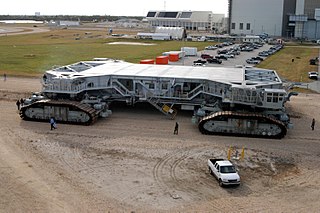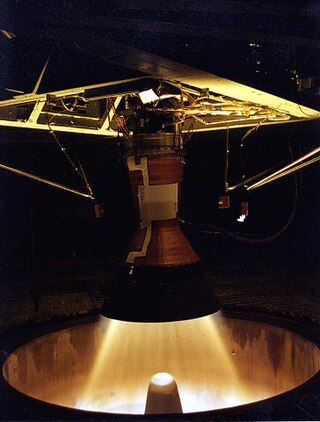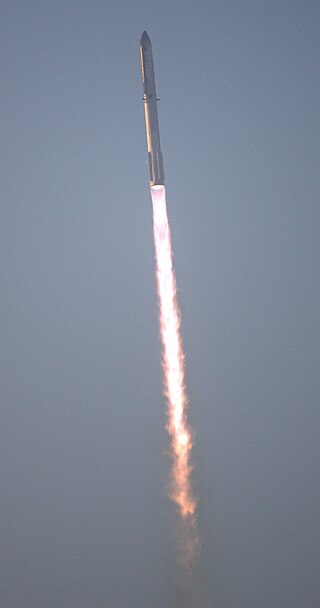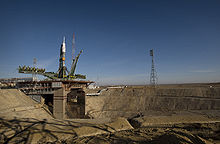
A rocket is a vehicle that uses jet propulsion to accelerate without using the surrounding air. A rocket engine produces thrust by reaction to exhaust expelled at high speed. Rocket engines work entirely from propellant carried within the vehicle; therefore a rocket can fly in the vacuum of space. Rockets work more efficiently in a vacuum and incur a loss of thrust due to the opposing pressure of the atmosphere.

A launch pad is an above-ground facility from which a rocket-powered missile or space vehicle is vertically launched. The term launch pad can be used to describe just the central launch platform, or the entire complex. The entire complex will include a launch mount or launch platform to physically support the vehicle, a service structure with umbilicals, and the infrastructure required to provide propellants, cryogenic fluids, electrical power, communications, telemetry, rocket assembly, payload processing, storage facilities for propellants and gases, equipment, access roads, and drainage.

Delta IV was a group of five expendable launch systems in the Delta rocket family introduced in the early 2000s. Originally designed by Boeing's Defense, Space and Security division for the Evolved Expendable Launch Vehicle (EELV) program, the Delta IV became a United Launch Alliance (ULA) product in 2006. The Delta IV was primarily a launch vehicle for United States Air Force (USAF) military payloads, but was also used to launch a number of United States government non-military payloads and a single commercial satellite.

The N1/L3 was a super heavy-lift launch vehicle intended to deliver payloads beyond low Earth orbit. The N1 was the Soviet counterpart to the US Saturn V and was intended to enable crewed travel to the Moon and beyond, with studies beginning as early as 1959. Its first stage, Block A, was the most powerful rocket stage ever flown for over 50 years, generating 45.4 MN of thrust. However, each of the four attempts to launch an N1 failed in flight, with the second attempt resulting in the vehicle crashing back onto its launch pad shortly after liftoff. Adverse characteristics of the large cluster of thirty engines and its complex fuel and oxidizer feeder systems were not revealed earlier in development because static test firings had not been conducted.

Blue Origin, LLC is an American aerospace manufacturer, defense contractor, launch service provider and space technologies company headquartered in Kent, Washington, United States. The company makes rocket engines for United Launch Alliance (ULA) and manufactures their own rockets, spacecraft, satellites, and heavy-lift launch vehicles. The company is the second provider of lunar lander services for NASA's Artemis program and was awarded a $3.4 billion contract. The company has three rocket engines in production including the BE-3U, BE-3PM and BE-4. The company is working on a fourth rocket engine called the BE-7 which is still under development and when completed may be used on planetary bodies other than Earth.

Launch Complex 39A (LC-39A) is the first of Launch Complex 39's three launch pads, located at NASA's Kennedy Space Center in Merritt Island, Florida. The pad, along with Launch Complex 39B, was first designed to accommodate the Saturn V launch vehicle. Typically used to launch NASA's crewed spaceflight missions since the late 1960s, the pad was leased by SpaceX and has been modified to support their launch vehicles.

The crawler-transporters, formally known as the Missile Crawler Transporter Facilities, are a pair of tracked vehicles used to transport spacecraft from NASA's Vehicle Assembly Building (VAB) along the Crawlerway to Launch Complex 39. They were originally used to transport the Saturn IB and Saturn V rockets during the Apollo, Skylab and Apollo–Soyuz programs. They were then used to transport Space Shuttles from 1981 to 2011. The crawler-transporters carry vehicles on the mobile launcher platforms used by NASA, and after each launch return to the pad to take the platform back to the VAB.

Launch Complex 39 (LC-39) is a rocket launch site at the John F. Kennedy Space Center on Merritt Island in Florida, United States. The site and its collection of facilities were originally built as the Apollo program's "Moonport" and later modified for the Space Shuttle program.

A mobile launcher platform (MLP), also known as mobile launch platform, is a structure used to support a large multistage space vehicle which is assembled (stacked) vertically in an integration facility and then transported by a crawler-transporter (CT) to a launch pad. This becomes the support structure for launch.

A rocket engine test facility is a location where rocket engines may be tested on the ground, under controlled conditions. A ground test program is generally required before the engine is certified for flight. Ground testing is very inexpensive in comparison to the cost of risking an entire mission or the lives of a flight crew.

Launch Complex 39B (LC-39B) is the second of Launch Complex 39's three launch pads, located at NASA's Kennedy Space Center in Merritt Island, Florida. The pad, along with Launch Complex 39A, was first designed for the Saturn V launch vehicle, which at the time was the United States' most powerful rocket. Typically used to launch NASA's crewed spaceflight missions since the late 1960s, the pad is currently configured for use by the agency's Space Launch System rocket, a Shuttle-derived launch vehicle which is currently used in the Artemis program and subsequent Moon to Mars campaigns. The pad had also been leased by NASA to aerospace company Northrop Grumman, for use as a launch site for their Shuttle-derived OmegA launch vehicle, for National Security Space Launch flights and commercial launches, before the OmegA program was cancelled.
Fondu Fyre, sometimes called Fondue Fyre, is a refractory concrete developed for specialist application. Fondu Fyre is a heat and erosion resistant concrete developed during the Apollo space program. It was developed to withstand the supersonic plume of a rocket engine during launch and hot-fire tests.

Launch Pad 0 (LP-0), also known as Launch Complex 0 (LC-0), or Launch Area 0 (LA-0), is a launch complex at the Mid-Atlantic Regional Spaceport (MARS) on Wallops Island, Virginia, in the United States. MARS is located adjacent to NASA's Wallops Flight Facility (WFF), which ran the launch complex until 2003. WFF continues to provide various support services to MARS launches under contract with the Commonwealth of Virginia.

As of 2023, SpaceX operates four launch facilities: Cape Canaveral Space Launch Complex 40 (SLC-40), Vandenberg Space Force Base Space Launch Complex 4E (SLC-4E), Kennedy Space Center Launch Complex 39A (LC-39A), and Brownsville South Texas Launch Site (Starbase). Space Launch Complex 40 was damaged in the AMOS-6 accident in September 2016 and repair work was completed by December 2017. SpaceX believes that they can optimize their launch operations, and reduce launch costs, by dividing their launch missions amongst these four launch facilities: LC-39A for NASA launches, SLC-40 for United States Space Force national security launches, SLC-4E for polar launches, and South Texas Launch Site for commercial launches.
Sites for launching large rockets are often equipped with a sound suppression system to absorb or deflect acoustic energy generated during a rocket launch. As engine exhaust gasses exceed the speed of sound, they collide with the ambient air and shockwaves are created, with noise levels approaching 200 db. This energy can be reflected by the launch platform and pad surfaces, and could potentially cause damage to the launch vehicle, payload, and crew. For instance, the maximum admissible overall sound power level (OASPL) for payload integrity is approximately 145 db. Sound is dissipated by huge volumes of water distributed across the launch pad and launch platform during liftoff.

NASA's Exploration Ground Systems (EGS) Program is one of three programs based at NASA's Kennedy Space Center in Florida. EGS was established to develop and operate the systems and facilities necessary to process and launch rockets and spacecraft during assembly, transport and launch. EGS is preparing the infrastructure to support NASA's Space Launch System (SLS) rocket and its payloads, such as the Orion spacecraft for Artemis I. Artemis I is the first to launch in a series of increasingly complex missions that will enable human exploration to the Moon and Mars.

Starship is a two-stage super heavy lift launch vehicle and spacecraft under development by SpaceX. It is the heaviest, tallest and most powerful space launch vehicle to have flown. Starship is intended to be fully reusable, which means both stages will be recovered after a mission and reused.

AgniKul Cosmos Private Limited is an Indian aerospace manufacturer based in National Center for Combustion R&D (NCRD) of IIT Madras, Chennai. The start up aims to develop and launch its own small-lift launch vehicle such as the Agnibaan, capable of placing 100 kg (220 lb) payload into a 700 km (430 mi) orbit. The first commercial launch was expected in 2022. However, no launch happened in that year.

On April 20, 2023, SpaceX performed the first integrated near-orbital flight of its Starship rocket. The prototype vehicle was destroyed less than four minutes after lifting off from the SpaceX Starbase in Boca Chica, Texas. The vehicle became the most powerful rocket ever flown, breaking the half-century-old record held by the Soviet Union's N1 rocket.

On November 18, 2023, SpaceX performed the second integrated near-orbital flight of its Starship rocket. The Starship successfully lifted off under the power of all 33 Raptor engines on the Super Heavy booster and made it through stage separation. Then, the booster had multiple engine failures and exploded, while the Starship continued to fly for over 8 minutes, reaching an altitude of 148 km (92 mi), above the boundary of space, before also disintegrating. The Federal Aviation Administration issued a statement confirming that an anomaly had occurred and that there are no reports of public property damage or injuries. SpaceX described the test as a success.




















